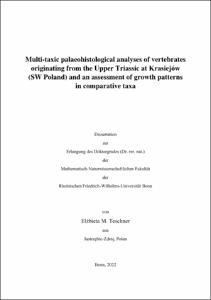Multi-taxic palaeohistological analyses of vertebrates originating from the Upper Triassic at Krasiejów (SW Poland) and an assessment of growth patterns in comparative taxa

Multi-taxic palaeohistological analyses of vertebrates originating from the Upper Triassic at Krasiejów (SW Poland) and an assessment of growth patterns in comparative taxa

| dc.contributor.advisor | Martin, Thomas | |
| dc.contributor.author | Teschner, Elżbieta M. | |
| dc.date.accessioned | 2023-03-29T09:24:37Z | |
| dc.date.available | 2023-03-29T09:24:37Z | |
| dc.date.issued | 29.03.2023 | |
| dc.identifier.uri | https://hdl.handle.net/20.500.11811/10733 | |
| dc.description.abstract | Palaeohistology is a good source of information about the biology of extinct animals as it provides insight into skeletochronology, metabolic rate or mode of life. The Polish Krasiejów locality recovers a unique Upper Triassic ecosystem with the aquatic temnospondyl amphibians Metoposaurus krasiejowensis, and Cyclotosaurus intermedius, the aquatic to semi-aquatic phytosaur Parasuchus cf. arenaceus, the terrestrial aetosaur Stagonolepis olenkae and the volant proterosaur Ozimek volans. This is the first study sampling phylogenetically distant, ectotherm taxa originating from one locality, with consideration of bone adaptation, phylogenetic relationship or ontogenetic stage, as a possible growth pattern alteration. Humeri and femora of all above-mentioned taxa were sampled in order to study the histological growth pattern and to analyse if the external, e.g., environmental and/or palaeoclimatic factors influenced the growth. Independent of the phylogenetic position or the ontogenetic stage, the temnospondyls, phytosaurs and aetosaur bones from Krasiejów grew with a lamellar-zonal bone type (LZB) consisting of parallel-fibred bone, grading into lamellar bone. A complete growth mark consists of a vascularised zone and an (almost) avascular annulus, but lacking the deposition of a Line of Arrested Growth (LAGs). Surprisingly, both the amphibians and reptiles grew with a similar pattern, despite their distant phylogeny, or different modes of life, implying a strong influence of external features on the growth pattern over the primary genotypic signal. The only herein studied taxon from Krasiejów showing, beside zones and annuli, the deposition of LAGs is O. volans; however, its unique pattern is most probably linked with the biomechanical bone adaptation to gliding. In addition, the comparative taxa sampled from German localities, namely the phytosaur Nicrosaurus sp. and the aetosaur Aetosaurus ferratus, and the Indian temnospondyl amphibian Panthasaurus maleriensis, showed that the animals grew also with LZB, the same as the Polish taxa, but either showed deposition of LAGs (Nicrosaurus) or revealed the ontogenetic influence, thus, the Aetosaurus were too young to be able to deposit growth marks. A comparison with literature data showed, that aetosaurs and phytosaurs from North and South America are characterised by a rapid deposited of fibro-lamellar bone type with multiple LAGs preserved, which is distinctly different from the specimens sampled herein. Further, the Moroccan metoposaurid, Dutuitosaurus ouazzoui, beside growing with LZB, similar to the taxa sampled herein, preserved multiple LAGs. This implies a strong influence of the external factors on the growth pattern on animals at the family level (e.g., Metoposaurus and Panthasaurus vs. Dutuitosaurus), occupying the same ecological niche but separated geographically; similar to aetosaurs and phytosaurs. Finally, this suggests strong climatic differences during the Upper Triassic between today’s Europe and Asia and that of North and South America and Africa. Moreover, it is astonishing, that animals from one locality, occupying different ecological niches seem to copy a growth pattern influenced by climatic and/or environmental conditions, rather than grow with the genetically induced signal. | en |
| dc.language.iso | eng | |
| dc.rights | Namensnennung-Nicht kommerziell 4.0 International | |
| dc.rights.uri | http://creativecommons.org/licenses/by-nc/4.0/ | |
| dc.subject | Paläohistologie | |
| dc.subject | Wachstumsmuster | |
| dc.subject | Trias | |
| dc.subject | Temnospondyli | |
| dc.subject | Pseudosuchia | |
| dc.subject.ddc | 560 Paläontologie | |
| dc.title | Multi-taxic palaeohistological analyses of vertebrates originating from the Upper Triassic at Krasiejów (SW Poland) and an assessment of growth patterns in comparative taxa | |
| dc.type | Dissertation oder Habilitation | |
| dc.publisher.name | Universitäts- und Landesbibliothek Bonn | |
| dc.publisher.location | Bonn | |
| dc.rights.accessRights | openAccess | |
| dc.identifier.urn | https://nbn-resolving.org/urn:nbn:de:hbz:5-70388 | |
| dc.relation.doi | https://doi.org/10.7717/peerj.9868 | |
| dc.relation.doi | https://doi.org/10.1163/18759866-bja10031 | |
| dc.relation.doi | https://doi.org/10.4202/app.01027.2022 | |
| dc.relation.doi | https://doi.org/10.1080/02724634.2023.2168196 | |
| ulbbn.pubtype | Erstveröffentlichung | |
| ulbbnediss.affiliation.name | Rheinische Friedrich-Wilhelms-Universität Bonn | |
| ulbbnediss.affiliation.location | Bonn | |
| ulbbnediss.thesis.level | Dissertation | |
| ulbbnediss.dissID | 7038 | |
| ulbbnediss.date.accepted | 24.03.2023 | |
| ulbbnediss.institute | Mathematisch-Naturwissenschaftliche Fakultät : Fachgruppe Biologie / Institut für Zoologie (IZ) | |
| ulbbnediss.fakultaet | Mathematisch-Naturwissenschaftliche Fakultät | |
| dc.contributor.coReferee | Yazykova, Elena | |
| ulbbnediss.contributor.orcid | https://orcid.org/0000-0001-5961-489X | |
| ulbbnediss.contributor.gnd | 1285305272 |
Files in this item
This item appears in the following Collection(s)
-
E-Dissertationen (4114)




